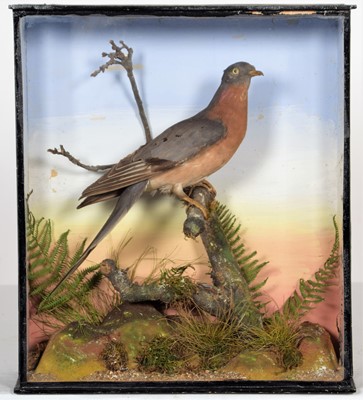20th May, 2022 10:30 GMT/BST
The James Harrison Collection of Birds
216
Taxidermy: A Cased Late Victorian Passenger Pigeon (†Ectopistes migratorius), a full mount adult male with head turning slightly to the right, perched upon a centrally mounted branch, amidst a natural setting of ferns, grasses and moss, above pebble covered groundwork, set against a watercolour painted evening sky back drop, enclosed within a typical period ebonised three-glass display case, 38.5cm by 14.5cm by 44cm, originally supplied in person to James Harrison by George Bristow, Taxidermist and Gunmaker, 15 Silchester Road, St Leonards-On-Sea, January 10th 1938, George Bristow was accused of selling foreign birds as British, taking advantage of wealthy collectors by charging excessively (see Nicholson & Ferguson-Lees, 1962; Morris 2021). James Harrison (1968, eg page 93) disputed this, offering evidence that Bristow did not maximise his opportunities. His son Jeffery, in an unpublished memoir in the Harrison Archives, supports his father's contention by making the following comment; "it is relevant....to detail the sum paid by my father in 1938 for another almost equally well-known extinct bird, namely a fine mounted example of a male Passenger Pigeon, for which he paid precisely £3!", This information may have been anecdotal father-to-son comment, but almost certainly backed by the data from family bank statements or cheque stubs. Photo copy of original correspondence between George Bristow and James Harrison included, attached hand written catalogue label to verso of case.
Passenger pigeons were hunted by Native Americans, but hunting intensified after the arrival of Europeans, particularly in the 19th century. Pigeon meat was commercialized as cheap food, resulting in hunting on a massive scale for many decades. There were several other factors contributing to the decline and subsequent extinction of the species, including shrinking of the large breeding populations necessary for preservation of the species and widespread deforestation, which destroyed its habitat. A slow decline between about 1800 and 1870 was followed by a rapid decline between 1870 and 1890. The last confirmed wild bird is thought to have been shot in 1901. The last captive birds were divided in three groups around the turn of the 20th century, some of which were photographed alive. Martha, thought to be the last passenger pigeon, died on September 1, 1914, at the Cincinnati Zoo. The eradication of the species is a notable example of anthropogenic extinction.
Sold for £7,000
Estimated at £7,000 - £10,000
Auction: The James Harrison Collection of Birds, 20th May, 2022
The James Harrison Collection comprises over 200 lots of cased and freemount birds dating from the late Victorian era to the middle of the 20th century. The collection includes rare and unusual examples, such as a passenger pigeon and a kiwi, as well as mounts by the likes of Rowland Ward, James Gardner, Charles Kirk and George Bristow.
James Maurice Harrison (1892-1971) was an ornithologist and one of the last great bird collectors, who gathered large numbers of specimens to study moult patterns, distribution, geographical and colour variation within and between species. A GP by profession, Harrison filled his family home and Doctor's Surgery, Bowerwood House in Kent, with his extraordinary collection.
Viewing
Wednesday 18th May 10:00am - 4:00pm, Thursday 19th May 10:00am - 4:00pm, and the morning of the sale from 8am. Viewing is open to the public, there is no need to make an appointment.
Sell one like this
If you've got a similar item to sell, complete the valuation form below and one of our experts will get in touch.


